How good is the feeling of sun on your skin after hibernating indoors over winter! Although its not quite summer, spring gives us a taste of sunnier, warmer days and time to venture back into the outdoors. However, unlike us, our trees and plants have been out there enduring the elements so this is a great time to give them a bit of a health check.
The following points will help you assess your garden and make efforts to increase the health of your trees and prepare for the warmer months to come.
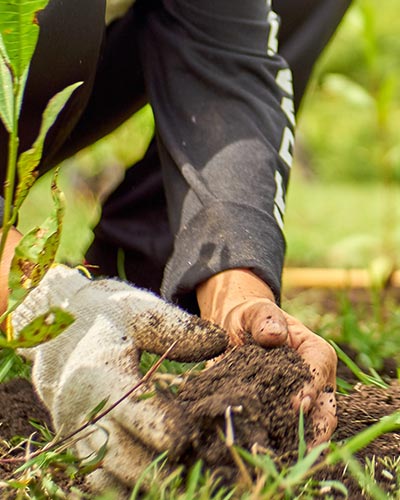
Soil and debris check
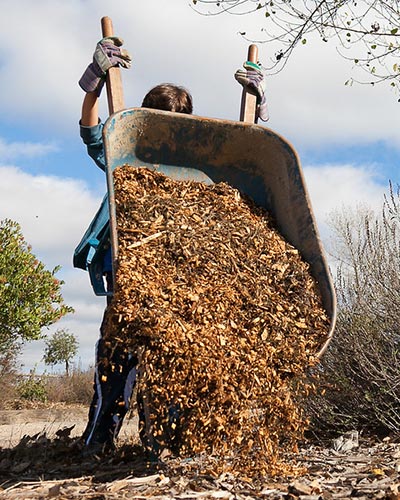
Mulching
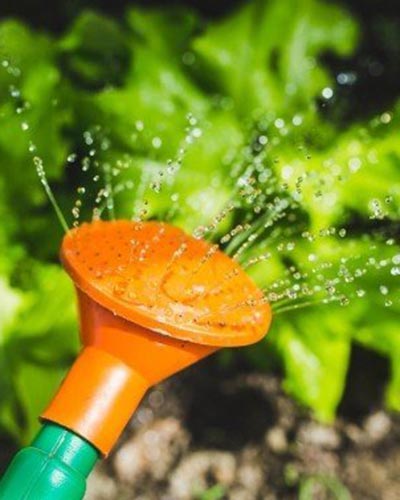
Watering and Planting
Once you’ve cleaned up and given your existing trees and plants the care they need, you may want to plant something new to enhance your gardens features. There is no real right or wrong answer or suggestion of what to plant but you need to make sure the right procedures have been done so that your tree has the best chance. Factors such as how big it will grow, to the type of soil you have, will it provide shade or be low maintenance? These are just some questions you’ll have to ask yourself before making final decisions.
We hope this has helped to give you some ideas about your trees and gardens over Spring. It really is such a lovely time of year, and not only will your trees benefit from a little TLC but you and other wildlife such as native birds will be able to enjoy the time you spend looking after your garden.
Until next time
Because healthy trees matter!
The ATC team
As the last colourful leaves fall for Autumn and we roll into Winter, its usually a good time to check the health of your tree, especially if it is deciduous. Trees become dormant during those cooler months making it the best time to prune. As some species have different dormant lengths compared to others there is a small window of opportunity to make sure the pruning is completed at the right time. Generally once all leaves have fallen the tree is at its optimal time to prune. Also it should be noted that pruning works such as deadwooding and removal of dangerous branches can be carried out at any other time through the year.
Many trees shed their leaves as a strategy to survive harsh weather conditions. The shedding of the leaves also helps to conserve the trees energy and water as the cooler weather approaches and settles in. The leaves are actively cut off in a process called abscission as the available nutrients are reabsorbed from their leaves locally into the bud for later use. One of the first things to break down is the Chlorophyll that gives leaves their green colour, hence why they change colour and eventually shed. Once a leaf has fallen a protective layer of cells grow over the exposed area of the branch.
There are of course some trees that don’t lose their leaves at all due to a protective coating on the leaves that can withstand the colder weather conditions and these are know as evergreens.
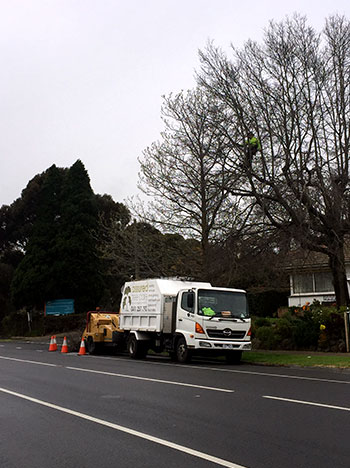
Weight reduction of previously lopped tree
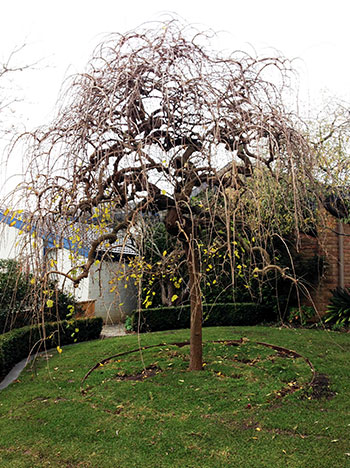
Tree pruning executed correctly
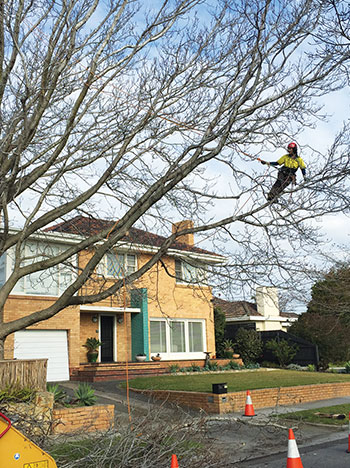
Uplifting and street clearing
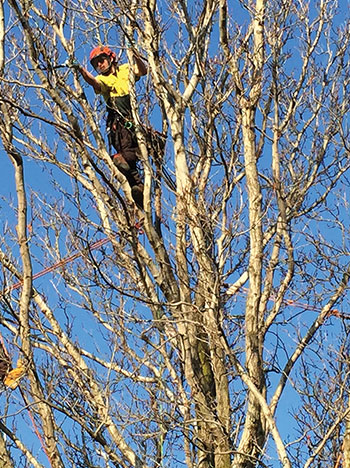
Deadwooding
Preventing Damage and Disease
Deciduous trees and shrubs are generally best pruned in the dormant period of cooler winter months as there will be less damage affected by pruning and shaping. The cuts made during this time will occlude much faster preventing pathogens and insects affecting the tree.
Tree Structure Evaluation
Since there are no leaves on the trees at this time it is much easier to see the structure of a tree. An arborist can assess what needs to be pruned and maintained, as well as any diseased, dead or broken branches that could potentially cause harm in the future.
Strong and Healthy
Pruning helps promote and encourage new growth, keeps the tree to a healthy size, and makes it stronger to sustain harsh weather conditions such as strong winds and storms. It also improves the trees air circulation. Deciduous fruit trees also benefit as it maximises fruit production.
We have regular clients on our database who are contacted biennially, yearly or bi annually for their pruning. If done properly and professionally as we do, then your trees will benefit substantially from the pruning work carried out.
For more information on pruning, head over to our tree pruning page here and don’t hesitate to contact us if you’d like an assessment from one of our qualified arborists.
Because ‘pruned’ trees matter!
Until next time
The Assured Tree Care Team
Have you ever had a knock on your door from a big burly bloke asking you if you want some tree work done?
Have you ever seen a neighbour having trees removed or pruned during early evening when the work day is well and truly over?
Do you know any elderly people who have been preyed upon for their vulnerability to have work undertaken?
If you have had this happen or know of someone who has, then this is the result of unprofessional tree companies trying to make a quick buck and manipulating a sale on unsuspecting customers. In other words a scam!
These fraudulent companies go door to door, or they may even approach you while you are out in the garden. They will give you some spiel about working at your neighbours and are just finishing up. But whats this? They have noticed that your trees around the property are actually unsafe and in need of work. They may suggest they are too close to electrical wires, which can be dangerous and that is how houses burn down. Or they may speculate that the tree is hazardous and needs pruning to prevent limbs falling and damaging your house in the event of strong winds or storms.
This plays on your mind and they offer you a ‘good deal’ its only available today and the price seems very cheap. Crisis avoided.
However this is not the case at all. They ask or ‘bully’ for the money up front and suddenly there are other issues that need to be fixed and before you know it they have hacked away at half your garden and left it in a bigger mess than when they started. In some insistence they may not even finish the job promising to come back tomorrow and then after multiple contact attempts you realise they aren’t coming back at all. Homeowners are then left with a mess they are not equipped to clean up and then have to source a more reliable service to do it for them.

Preying on the elderly
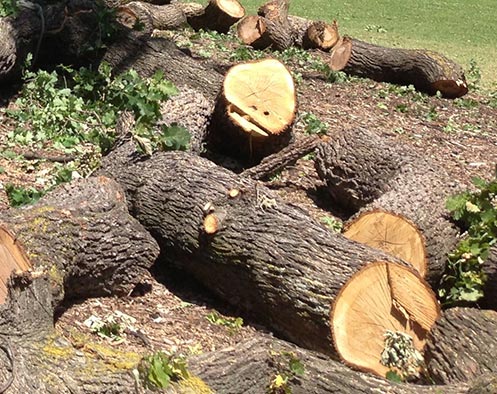
Mess left behind
As with most trade services, the tree industry works on clients contacting us not the other way around. Sure we do marketing and advertising runs as a way try to drum up work, contact existing clients if its time for their yearly tree maintenance, but we would never go door to door inventing work on properties.
Reputable tree companies should be recognised for the following:
Things to remember if you are approached via door knock or in person:
The tree industry has grown rapidly in the last decade. It feels like every where you look a new truck and chipper is popping up on the roads or in your neighborhood. Unfortunately though, as we’ve seen not all companies are created equal, so please be cautious, or next time you are after some tree work done just call us! Having the knowledge and upper hand in this situation we can ‘weed’ out the hackers and keep out industry free from unnecessary tree damage. Just remember to ask for an up front quote in writing, insurance cover, ethic advice and a trusted professional.
Because we all know trees matter!
Until next time
The Assured Tree Care Team
Away from the huge crowds of the General Sherman Tree in the adjoining national park sits the second largest tree in the world the General Grant Tree. Standing tall as the centre piece of Grant Grove in Kings Canyon National Park, it also has the title of the widest known sequoia in the world!
Some of the research I found initially put it as the third largest tree but it was moved up a notch in 2005 when the Washington Tree partially collapsed due to a fire reducing its volume. Actually, up until 1931 it was thought that the General Grant Tree was the largest in the world but after more precise measurements were taken it was the General Sherman who came out on top. You can read about that tree here.
America is a very patriotic nation so it is no surprise that they name certain things after people who have served their country. This tree is no exception. In 1867 it was officially named after Ulysses S. Grant, a Union Army general and also the 18th president of the United States of America who served from 1869-1877. There is however some controversy surrounding who actually named the tree though. It was always thought that lumberman Joseph Hardin Thomas who had discovered the tree in 1862 claimed its name then. However in August 1867 a pioneer called Lucretia P. Baker who had camped near the tree wrote to President Grant about naming the tree after him, to which he sent her a letter of reply to thank her for the honour. Either way the tree went on to be declared as the “Nation’s Christmas Tree’ on 28th April 1926 by President Calvin Coolidge. An annual holiday service is held around the base of it each year. 30 years later President Dwight D. Eisenhower designated it as a National Shrine as a memorial to honour all those who died in the war and given to their country. No other living being has been given the same status. Pretty amazing!
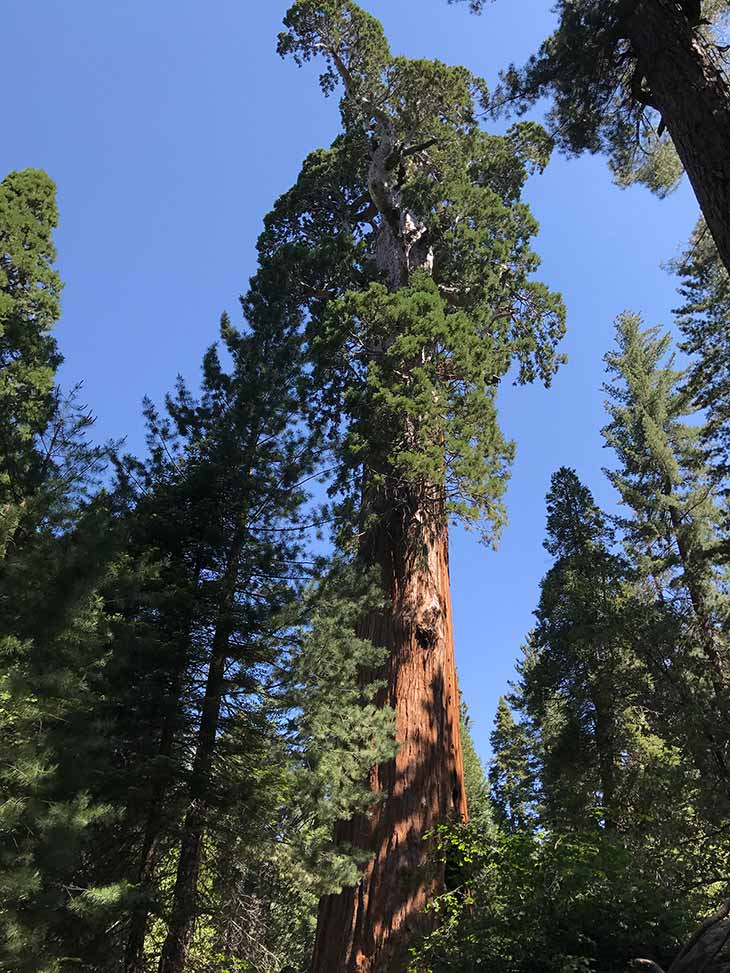
Below are the stats for the General Grant Tree:
Age – 1,700 years old.
Weight -1,245 tons
Height – 81.7 meters
Diameter at the base – 12metres
Circumference – 33 metres
Volume – 1,320 cubic metres
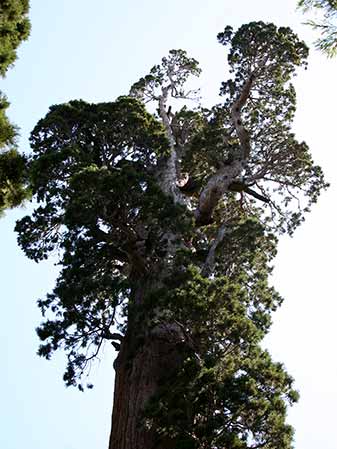
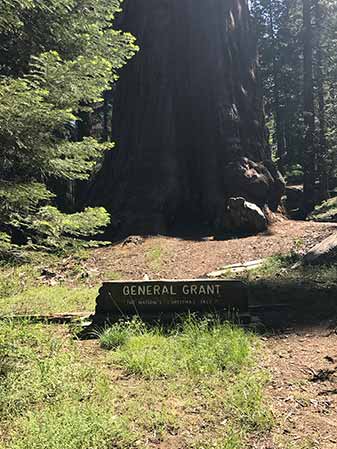
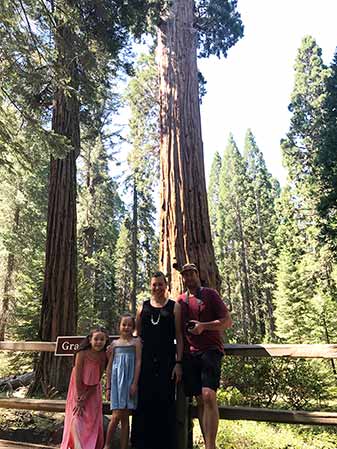
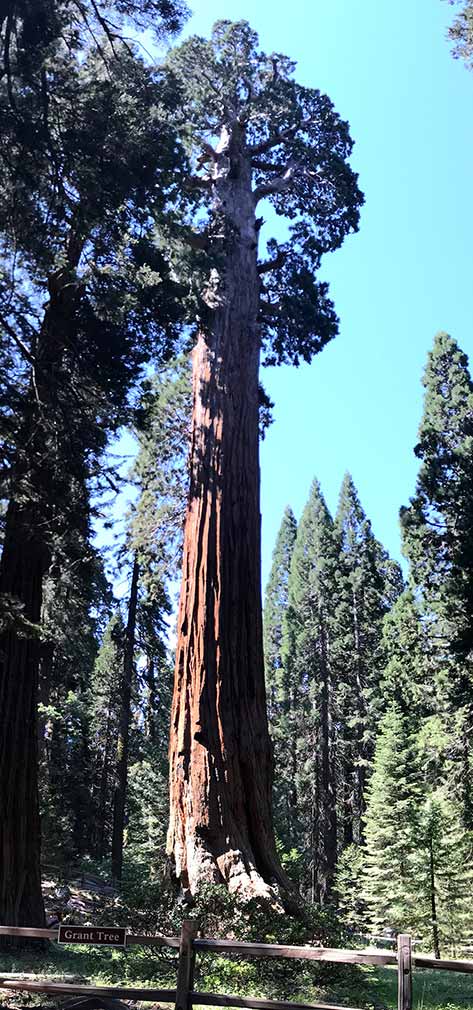
There is also some great history on the trail to this tree. Before entering there are some amazing trees in the carpark alone! There is also an interesting tree called the twin sisters which didn’t seem to have much information that I could find on it.
Before arriving at the Grant Tree we saw a very old cabin still standing in reasonable condition. It was called Gamlin Cabin and was built in 1872 by Israel Gamlin. He used it with his brother for 6 years while they grazed cattle and filed a timber claim for 160 acres. Later on it was used as a store house for the U.S cavalry once the national park was established. Then years later it was the quarters of the first park ranger.
Also along the track is the Fallen Monarch, a giant sequoia that fell in the 1900s. The beauty of sequoias is how they resist decay and continue to endure even after they have fallen. The sheer scale of it is incredible, like the Gamlin Cabin and being hollow it was welcomed shelter to house visitors and cavalry to the park in those early years.
The last notable piece of history we saw along the track was the centennial stump. The tree that belongs to this stump was cut down in 1875 taking 2 men 9 days to cut it down. A 16 ft section of the tree was taken away and hollowed out then reassembled and exhibited in the 1876 centennial exhibition in Philadelphia. It was labeled the ‘California hoax’ by eastern people refusing to believe such a giant sized tree would exist. Sadly three other nearby trees were cut down and shipped across the country to exhibit. The Mark Twain Tree is still on exhibit today in London and New York.
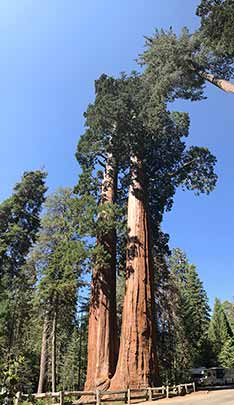
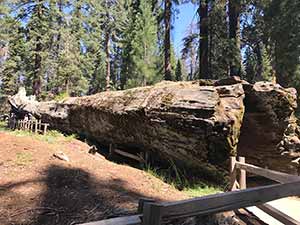
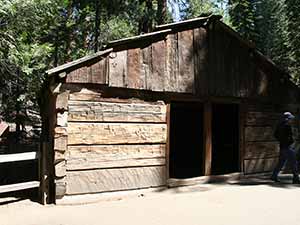
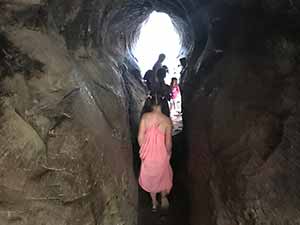
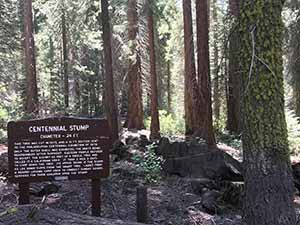
Twin Sisters Tree, Fallen Monarch, Gamlin Cabin and the Centennial Stump
We all really liked the Grant Tree and all that Grant Grove had to offer, it had a calmness around it when we visited that wasn’t there when we saw the General Sherman. The national parks in this area are simply breathtaking. Until you have walked within a giant forrest it is hard to put into words how amazing they are. Although we only stayed in the park for a night we feel lucky enough to have seen them and would definitely go back to explore and stay longer. If you are into your trees like we are then the national parks in California are definitely worth a visit!
Because walking under GIANT trees matter!
Until next time
The ATC travel team
Our road trip through California took us into the Sequoia National Park, home to deep valleys,distinctive rocks, giant forests, famous sequoia trees and the largest trees in the world!
Established on 25th September 1890, the Sequoia National Park spans over 400,000 acres. It was California’s first national park and is America’s second oldest national park after Yellowstone. It is also part of the Sierra Nevada a mountain range that spans not only the Sequoia National Park, adjoining Kings Canyon National Park, but also Yosemite.
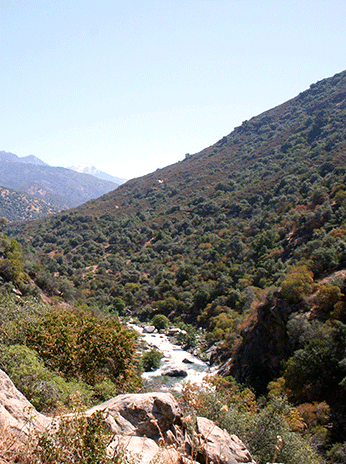
Sequoia National Park
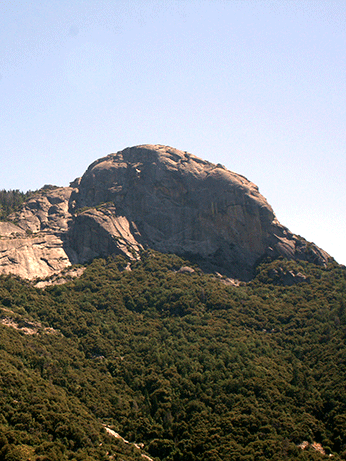
Moro Rock
The scenery into the park is stunning, and changes both in its landscape and temperature as you get further into the giant trees. As the General Sherman is no ordinary tree, its not that easy to park your car and get out to see it. So with parking at a premium the best way to get to the trail is to hop on a free shuttle bus, which is what we did. There are 2 trails that lead to the Sherman Tree. The trail we went on runs 0.8 km down to the tree as you enter the Giant Forest sequoia grove. This area was named by John Muir who was a pioneering conservationist who fought to protect these amazing trees. The area is also home to 3 other of the worlds largest trees besides the General Sherman.
This gargantuan sequoia tree was named by James Wolverton in 1879, who was a cattleman that served as a lieutenant in the 9th Indiana Cavalry, under General William Tecumseh Sherman in the Civil war. It was labeled the largest tree in 1930, not by height or width but by shear volume. It adds new wood each year and is still growing. The new wood is the equivalent to a normal size tree of around 18m! During winter in January 2006, the largest branch fell shattering the walkway and fence below. This branch was larger than most tree trunks with a diameter of 2m and length of 30m. However that did not effect the ranking as the largest volume tree as its calculated on the trunk volume not branches.
The tallest tree title belongs to the Hyperion which is a California Redwood and stands at 115.7m tall and is approximately 800 years old. Its location is not easily accessible and its only known to be in a remote area of the Redwood National Park.
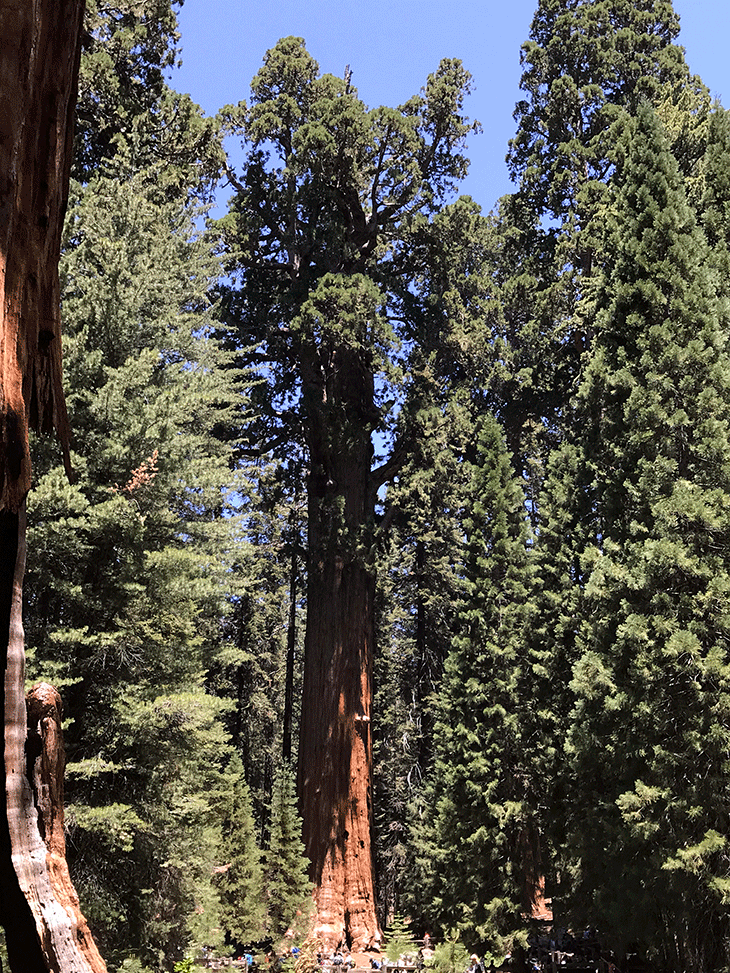
Below are the stats for the General Sherman:
Age – 2,200 years old.
Weight -1385 tons
Height – 83.8 meters
Diameter at the base – 11.1metres
Circumference – 31 metres
Volume – 1,487 cubic metres
So why do Sequoias get so big and live so long? This is due to unique combinations of traits. They are fast growing, their bark has tannins which resist disease and rot, the bark is extremely thick and somewhat resistant to fire so it doesn’t burn like other trees, and they have an extensive root system with good availability to water to help them to survive the challenges that other trees cannot. While most trees only live a few hundred years the sequoias are able to live for over 3000! Sequioas naturally grow only on the west slope of the Sierra Nevada usually between 1500-2100 metres in elevation. The main cause of these trees dying is simply toppling over. Like most trees they have a shallow root system with no taproot. Excessive soil moisture, strong winds and root damage can lead to poor structural health and therefore the trees can fall.
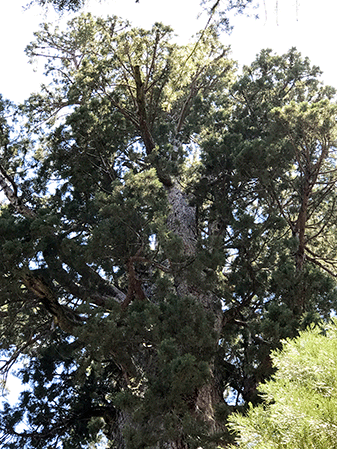
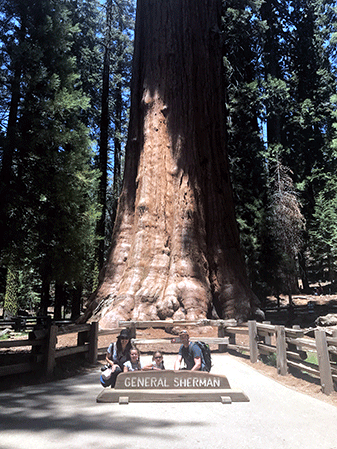
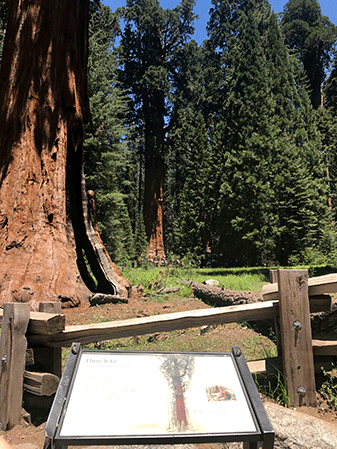
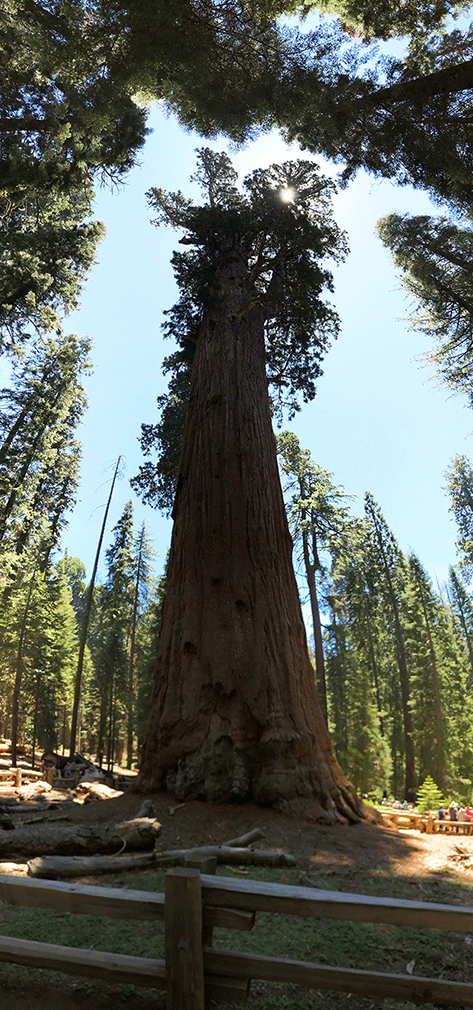
The General Sherman’s enormity can’t really be expressed in photos, after all a 6ft human looking up at it is about the equivalent to a mouse looking at a 6ft human! It definitely is a tourist crowd pleasure but this area is stepped in so much rich history as well which is what also makes it an important landmark. It has been an attraction since the first wagon road was constructed in the early 1900s and it will continue to draw visitors for many years to come. We feel very lucky to have seen it and experience this amazing natural wonder in the Giant Forrest.
Because BIG trees matter!
Until next time
The ATC travel team
This past July we were lucky enough to travel over to the California in the United States of America to explore some of their national parks and giant trees. Over the next few weeks we’ll feature some of the trees we saw and some of the interesting history about California’s natural wonders.
Our first stop was Santa Barbara, a beautiful sea side city on the West Coast of California that lies between the Pacific Ocean and the Santa Ynez Mountains. It is known to be called the American Riviera due to its Mediterranean style weather, sandy beaches and is a popular tourist and resort destination. One of the focal points of the downtown area in Santa Barbara is State Street with its architecture, shopping and food. State Street also leads you to their picturesque harbour and Sterns Wharf.
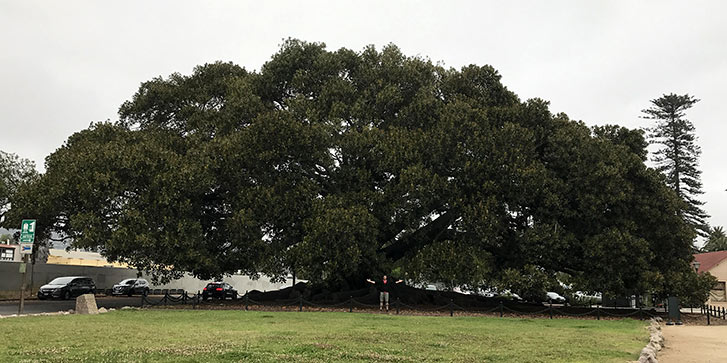
It is on State Street where the story of this giant tree begins. In 1876 a visiting sailor from Australia gave a seedling of the Australian Moreton Bay Fig to a local girl, who planted it at 201 State Street. The young girl moved away and it was transplanted a year later by her friend Adeline Crabb to the corner of Montecito and Chapala Streets. The land which was originally owned by the Southern Pacific Transport Company, is today remembered by a historic train carriage sitting next to the fig.
It is most likely due to its closer proximity to the ocean, only a block away, and Santa Barabara’s climate that this tree has done so well here. The Moreton Bay Fig (Ficus macrophylla) is native to the coastal and mountain rain forests of Eastern Queensland and New South Wales. Named after one of Eastern Australia’s major sea ports it is also known as the Australian Banyan. Typically this large spreading evergreen grows up to 130ft (39m) tall with spread nearly as great and a buttressed trunk.
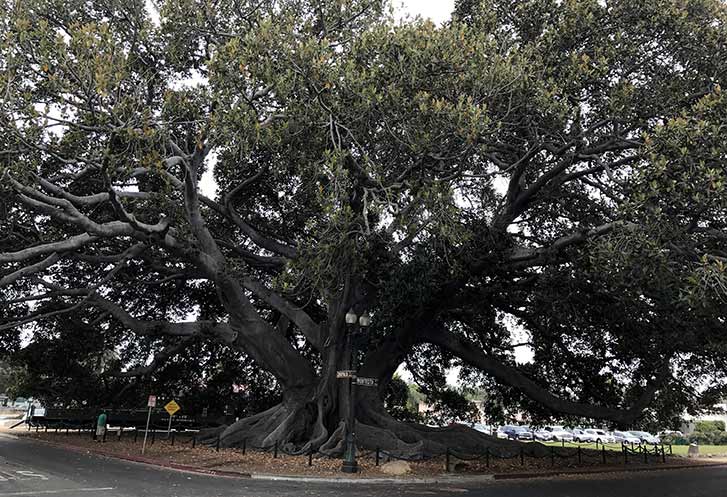
In 1997 this particular fig was measured with an average crown height of 176ft (53m) and stood at 80 feet (24m) high. The circumference was also measured at 12.65m It is believed to be the biggest of its kind in the United States and is on the register of Big Trees. The tree was officially designated as a California Historical Landmark in 1970, and the property was deeded to the City of Santa Barbara in 1976.
There is also a plaque below the tree detailing that its ‘The children’s peace, love and understanding tree to celebrate John Lennon’s birthday on October 9th as the International Day of Peace’. Although the actual day of peace is the 21st September, this recognition of the tree makes it a welcoming place for all to visit. It really is a stunningly beautiful tree and hopefully the photos do it justice!
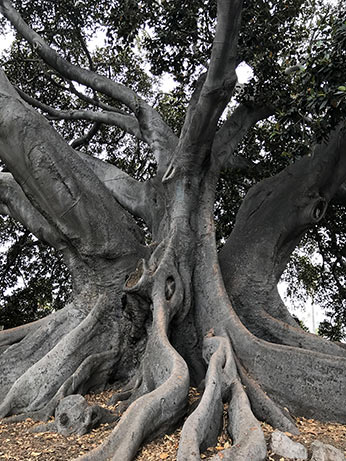
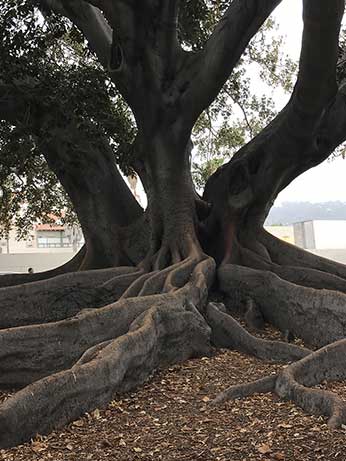
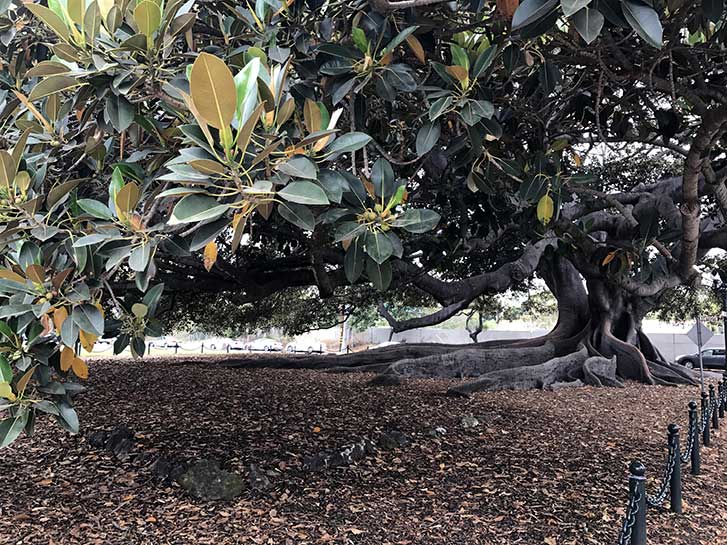
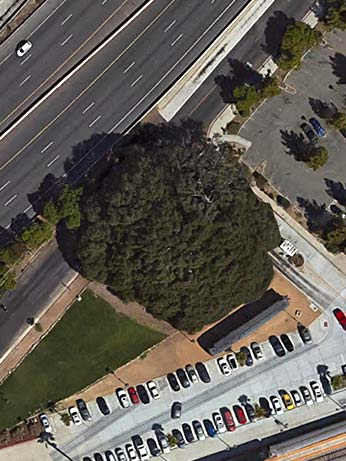
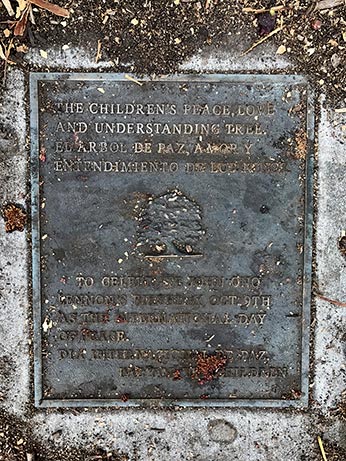
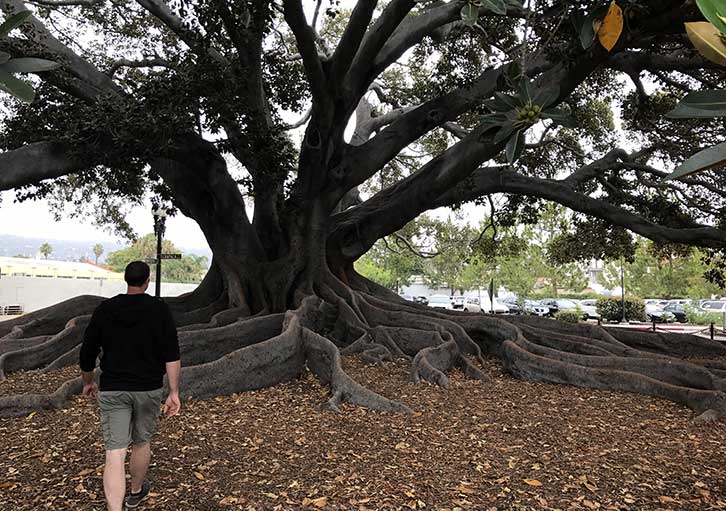
Because BIG trees matter!
Until next time
The ATC travel team
Christmas is a fabulous and busy time of year. We love it here at Assured Tree Care for everything that it is, the Christmas carols, the lights, the celebrations and most of all the Christmas tree! This is a special tradition in our house and we always get a real one. Not to say that those who chose the fake ones to put up on the 1st December are any less significant but there is something about the smell a real pine tree that brings the magic of Christmas together.
As much as our young girls would love the tree at the start of December, we usually get it about a week or so in. We are wary of caring for it and making sure the branches don’t droop too much, we have pine needles falling and it is still healthy enough come Christmas day.
The main thing to remember when buying a real Christmas tree is water water water! We try to water it everyday to ensure it doesn’t dry out too much. We recommend putting it in water as soon as you get home. Try to keep up the water every day, some days it may take more than others.
If you have purchased your tree from a supplier or tree farm, you may need to cut the bottom again. The amount may depend on how high it will look in your room. It is a good idea to cut at least 5-10cm off prior to mounting your tree. A fresh cut and quickly into water will ensure your tree is not stressed too much. It is important not to let this cut dry out. Once the tree is up and positioned correctly the fun part is decorating!
When Christmas is over the tree is somewhat neglected and pulled down and then its the dreaded question of how to dispose of it! Lots of people leave them on the nature strip until they are completely dead and brown, which can be a bit unsightly for your neighbours. As real trees are biodegradable they can be reused or recycled for mulch etc.
There are a number of ways to dispose of them and these are:
A quick google search will give you options for your local area.

Troy, Russ and Rob – arborists

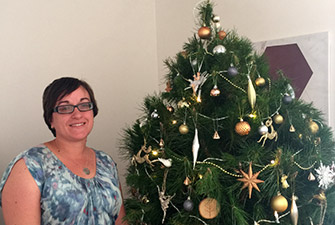
Bianca and Kim – admin
Now that the Christmas season is well and truly upon us we will be busy up until the 23rd December and the team will take a short break before we get straight back into it all again in early January in 2017.
So from our family to yours we wish you all a very merry and safe Christmas and new year and look forward to seeing you back here next year with some more articles to get you informed!
Because trees (especially Christmas trees) matter!
Until next month and next year
The Assured Tree Care Team
Melbourne’s weather has been very temperamental in recent years and with the effects of climate change we have begun to see unusual and unseasonal characteristics with some of our trees. This isn’t helped with the change of seasons especially as spring rolls into summer.
The best way to protect you and your home from potential damage is to manage the risk of your trees. This can be done by having regular tree inspections, tree pruning and removal of any problematic branches and limbs that could cause damage.
As the weather starts to warm up it is also important to make sure your trees are given enough water to drink and are well maintained to prevent them from dying off, this includes mulching. Mulching now will help moderate soil temperatures and reduce evaporation in the warmer weather. The natural process of breaking down mulch also adds valuable nutrients and increases microbial activity in the soil. Healthy soil leads to a healthy tree.
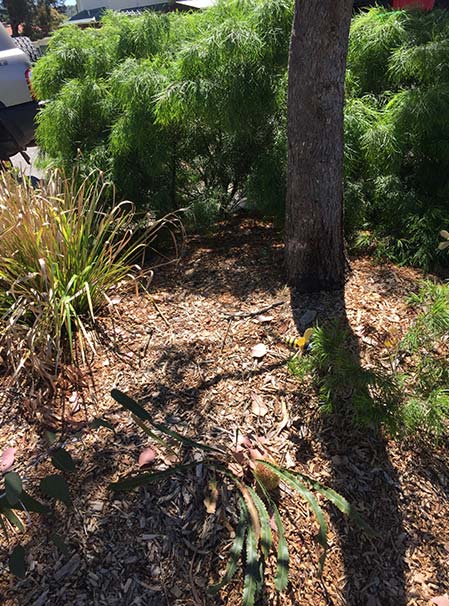
Mulched garden
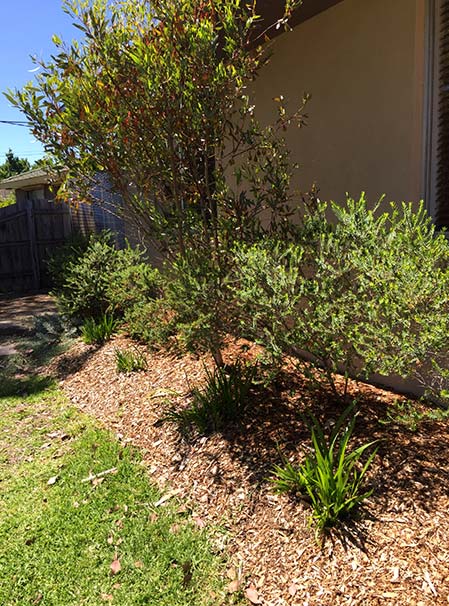
Healthy trees with Mulch
If you are have any concerns about the health or structure of your tree your best plan of action would be to give us a call or contact us through the website. We can arrange a consultation to discuss what procedures to take. We also sell limited amounts of mulch depending on the quality of the tree so please let us know if that is something we can help with.
Because trees matter!
Until next month
The Assured Tree Care Team
Spending its time on the mainland over winter in Victorian forests and along Australia’s eastern coastline, the Swift Parrot is now heading back to Tasmania. Flying over the strait from August, spring time in Tasmania is the only place they like to breed. Many years ago this was a fine place to nest, searching out Blue Gums and the hollow of a trunk. These days however, tell a very different story as this colourful little bird fights extinction.
Earlier in July this year, a group of illegal wood collectors were discovered cutting down thousands of trees in a patch of forest at Buckland in Tasmania. The crown land used as a breeding ground for Swift Parrot had been repeatedly targeted by car loads of men and chain saws. It may seem trivial to those absent-mindedly cutting these trees for firewood but for those involved in the plight to save the Swift Parrot, this has come as a devastation.
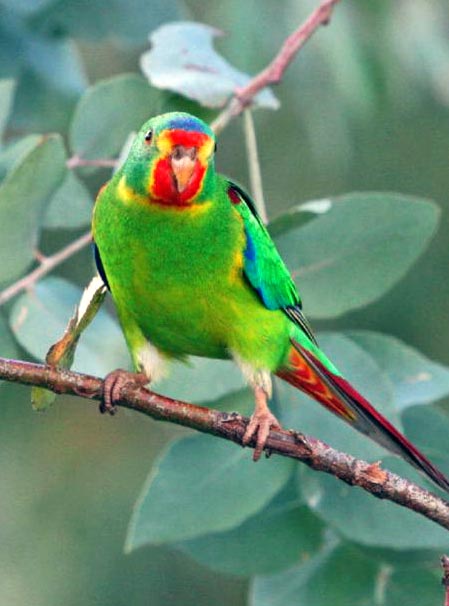
The Swift Parrot
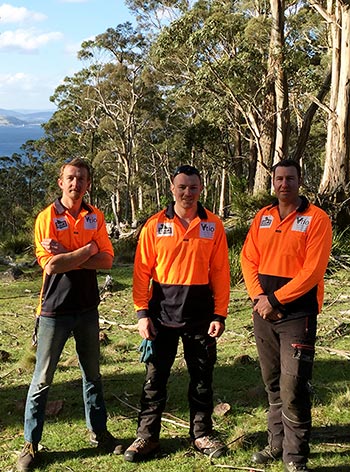
Rob, Troy and Russell on Bruny Island
Conservation biologist Dr Dejan Stojanovic from the Australian National University, was the one to discover the trees and nests had been destroyed. He has been researching the Swift Parrot for a number of years, dedicated to creating habitats to keep them from extinction. The site had been one of the most important in Tasmania with 18 nest trees being monitored since 2010 and now only 8 remain. Illegal firewood cutting, logging of old growth forests and clearing farm lands has meant a that a lack of hollow trees available to these birds has severely restricted their breeding opportunities. With the loss of habitats it is also more likely that predators such as sugar gliders can kill the female parrot and her eggs. As there is an estimate of around 2000 left in existence the Swift Parrot is listed as critically endangered.
Dr Stojanovic discussed their plight on ABC’s radio National earlier this year, and it was then Andrew McKernan, the secretary of the Victorian Tree Industry Organisation (VTIO), heard him and thought something must be done. McKernan was put in contact with Stojanovic and through the VTIO a team of 33 arborists from Victoria, Sydney and Tasmania joined together to volunteer their time and resources to help the beautiful bird have a better chance at survival.
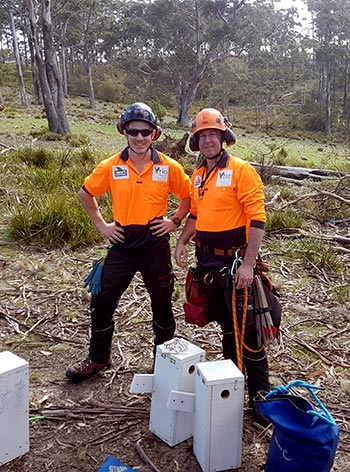
Troy and Russell with nesting boxes
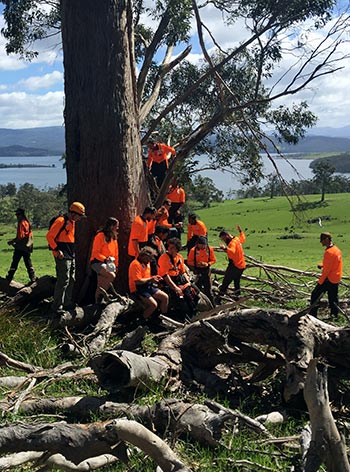
Some of the voluteer arborists
So as active members of the VTIO, our crew were some of the arborists who volunteered their time to save this endangered bird. Russell Shepherd, who is current Vice President, Troy Taylor and Rob Shaw headed down to Tasmania over the weekend of the 8th and 9th of October to help with habitat creation for the Swift Parrot. With the work ute loaded the guys took the Spirit of Tasmania overnight to Devonport. Once there it was a car and ferry ride to another breading site located on Bruny Island.
Access has been restricted in Buckland due to the ongoing police investigation, so Bruny Island served as another perfect spot to create habitats. The birds are quite fussy about where they breed so the size of the hollows and construction needs to be quite precise. Peppermint trees on the island were a great tree to climb the 10-15m needed to create the hollows. They were close enough to the Blue Gums, which are currently flowering and providing an abundance of food for the parrots. Chainsaws may seem as an unlikely saviour for these birds, but as it can take up to 120 years for a hollow to form in a tree, the man made hollows are the next best things.
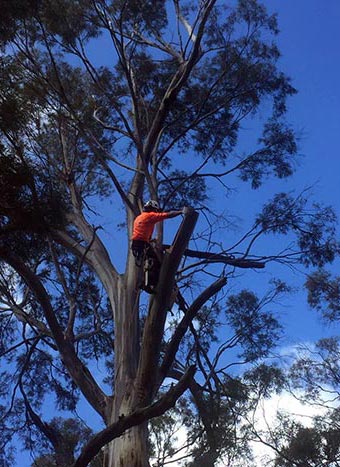
Carving out hollows
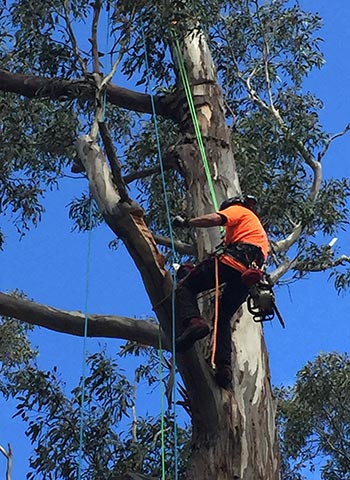
Troy carving out hollows
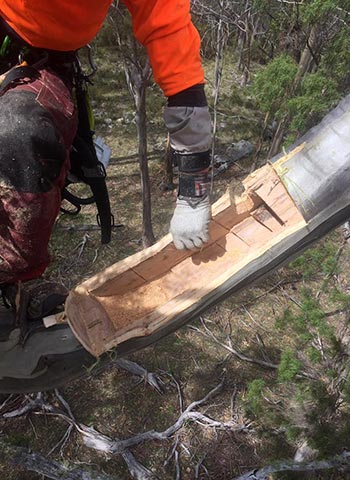
Carving complete
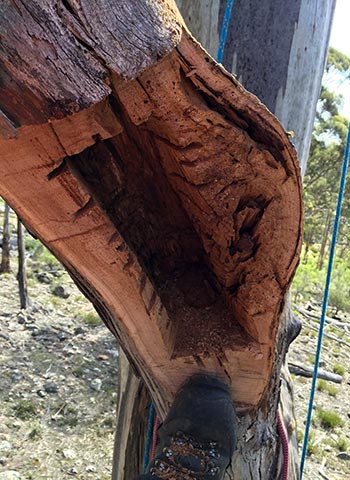
Russell working on a carving
There are 2 ways in which the group helped create new habitats for the birds. One was to cut a face plate from the tree, hollow out the tree then cover it back over with the face plate. There also needs to be a small hole made approximately 50 mm wide on the other side for the birds to enter. This allows the parrot to get into the hole without predators such as the sugar glider entering and taking the eggs. Essentially they are mimicking what would take years for a hollow to form and hopefully will last at least 50 years or longer.
The other way is the purpose built nesting boxes. About 300 have been built by the Green Army to help house the birds. These are then attached to the tree. There were some installed earlier this year and they have already proved to be successful. Although not as robust as the hollow carvings they are still proving to help with the breeding process.

The guys heading home after a great weekend
A few days after the team returned we had word that the Swift Parrots had in-fact arrived on the island and began searching out nests to breed. Great news for Stojanovic and his team! This will all be closely monitored by them to see how the Parrots adjust, but they do warn this is really only a band aid solution for now. Although they are buying them some much needed time, the real issue is that something should be done to preserve mature Tasmanian forests so that nature can provide for these birds.
There were a lot of great people who gave up not only their time on the island to build habitats but also others who took photos and videos of the weekend. To get a lovely overview and vibe of this expericence please have a look at the link below put together by Tom the Tree Wizard.
The media also gave this some coverage running articles leading up to and at the time of the volunteers helping on the island so head over to abc.net.au for their coverage of the weekend and full transcript.
See the full 7.30 Report coverage here.
It really was an amazing experience for our team to be a part of. They met some great fellow arborists, they had a few good laughs and made the best of an ATC road trip! Using skills and equipment for something other than general tree work was a rewarding opportunity, especially when its helping a bird that is really fighting to stay around and grace us with its colour and beauty. Giving back is something that makes everyone feel good!
Because trees (and saving wildlife) matters!
Until next month
The Assured Tree Care Team
We have two girls that attend a primary school that have a number of trees on the property. We send them to school every day entrusting in the school to keep them happy and safe. Our school like all schools have a duty of care and safety to their students, staff and parents inside and outside the classroom.
Many of our schools have an aging tree population as most of the trees were planted around the time the school buildings were built. With so many mature species on the grounds their integrity may be called into question. If these older trees are in stress or decline it is more likely for them to have limb failure. As in the case in 2014 when a Sydney school girl was crushed and died from a falling branch. As a result of this tragedy the New South Wales Government invested $32 million into the removal of 9000 trees from schools and introduced mandatory annual tree audits.
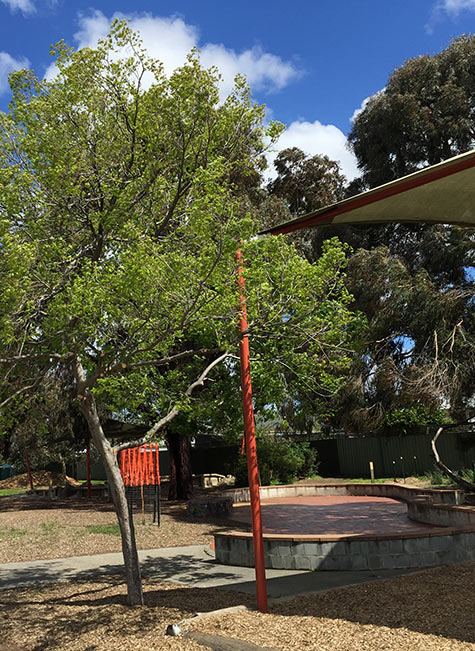
Tree pruning at Bell Primary School
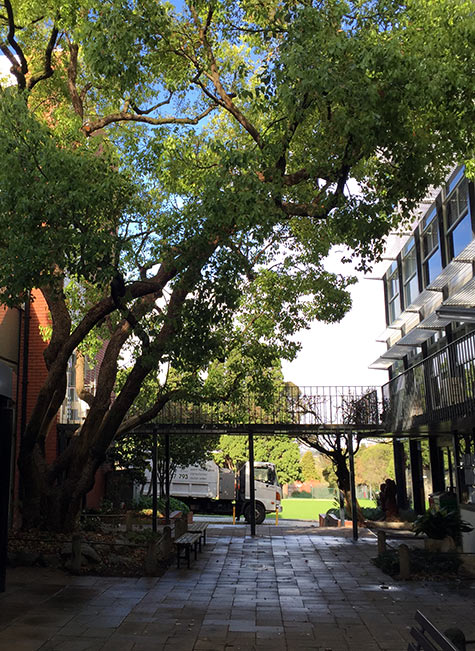
Pruning at a Korowa Anglian Girls School
All Australian schools should engage with a consulting arborist to review the trees on site, especially those that are overhanging playgrounds and buildings, aging and showing signs of failure. A tree inspection by a consulting arborist should be a part of all OHS policies for schools. Unless an assessment is done we cannot always see the conditions that may lead to other failure or the potential damage that can be caused during and after storms and strong winds. There are many schools that don’t have a plan in place but by having an audit, routine inspections and maintenance, the health and safety of the trees may just save a life.
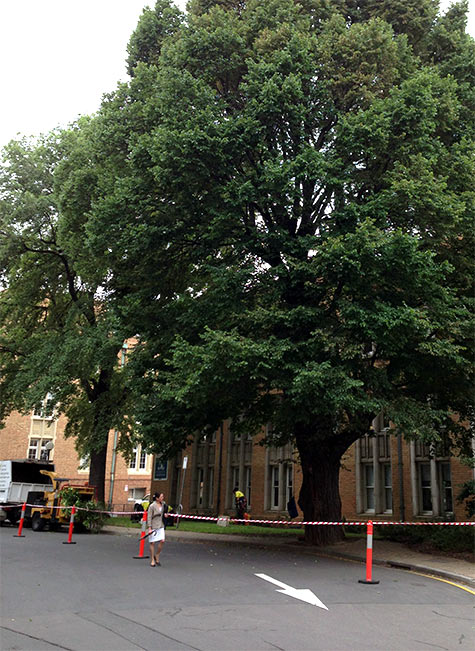
Grounds work at the University of Melbourne
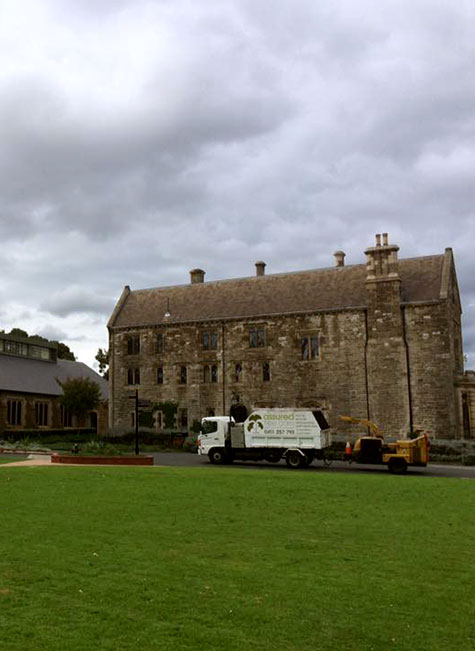
Grounds work at Trinity College
Here at Assured Tree Care we have over the years, built a strong reputation in the education sector as we work with a number of schools and colleges each year. We are also increasingly receiving more and more enquiries from schools requesting audits. We currently provide audits for universities, colleges, schools and preschools to ensure the trees on the grounds are maintained in a safe and healthy condition. We assess regular maintenance and manage the risks associated with trees in the urban environment.
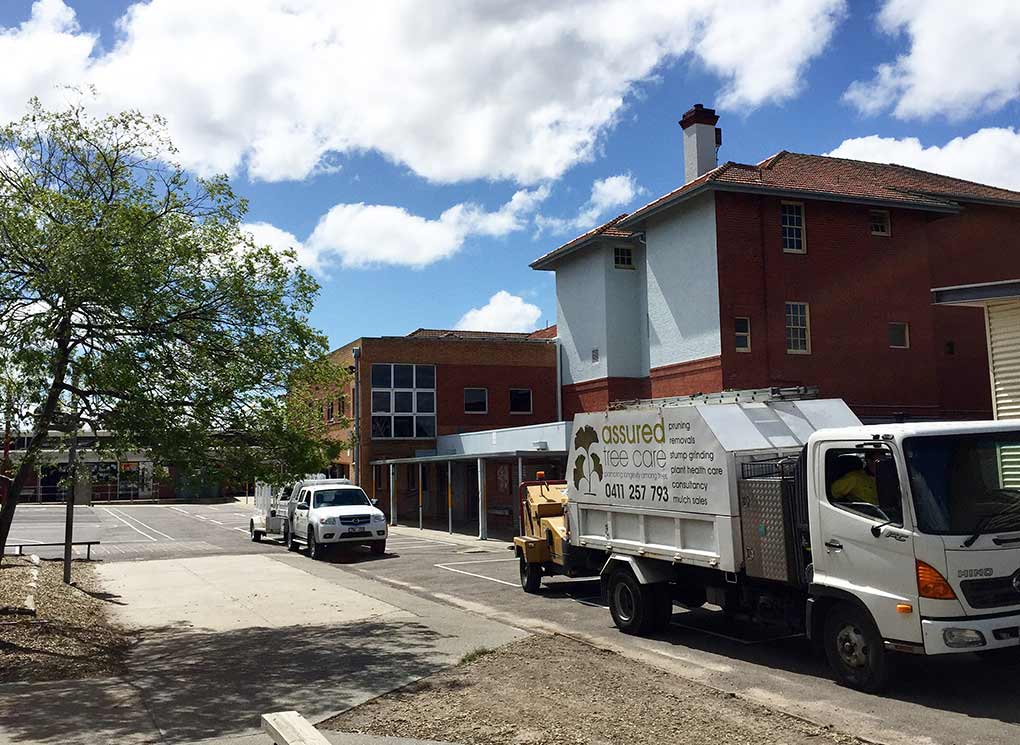
If you are from a school or are concerned about a school’s trees then contact us. One of our consulting arborist will discuss problems related to the trees on the grounds and arranged a time to have a walk through. We have procedures and time lines to help you put a management plan in place.
Once specific trees and concerns have been raised the arborist will inspect and record all relevant data related to the health and safety of the tree. Some of this information will include details on health and structure, canopy size and condition as well as looking at any disease or pests that may be present. We will then write up a report that will document all of the data collected and offer recommendations for those that may need extensive pruning, treatment or removal.
Costings for recommended works is then estimated to assist in budget forecasting. Once costing has been approved a tree management program will be put in place and trees which prove to be the most hazardous will be attended to first.
By undertaking regular maintenance work we help to keep the grounds safe from potential hazards. If trees are to be removed we can also offer a suitable replacement tree and planting service.
Below is an example of a tree management plan
1st year
Initial audit report
2nd year
Review
3rd year
Review and audit
We’ve said it before and we’ll say it again, trees are treasures to us, but even more important are our children who we treasure more than anything. We want them to thrive in an environment rich with trees and nature but also for it to be a safe one. If we can prevent another tragedy then we have done our job.
Because trees matter!
Until next month
The Assured Tree Care Team